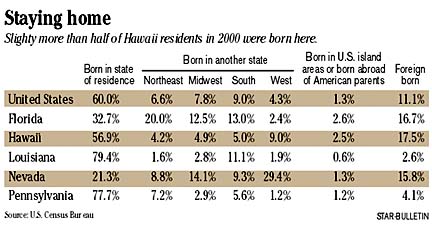
Moving bug bites
country, islesAbout 43 percent of people
in Hawaii changed addresses
from 1995 to 2000
In the last five years of the 20th century, close to half the population of the country and half the state of Hawaii packed up and moved to different homes.
Almost 46 percent of people in the country moved between 1995 and 2000; in Hawaii, 43 percent of the 1.2 million residents moved, according to new U.S. Census Bureau data.
When it came to moving into the state, Hawaii at 11 percent ranked above the national average of 8.4 percent. The survey doesn't address moves to the mainland.
During the mid- to late-1990s, when the Hawaii economy languished, economists warned of a severe "brain drain" of young people moving to the mainland for better jobs.
But more of the drain had to do with a national policy of downsizing the military during the Clinton administration than with losing hordes of young professionals, said Paul Brewbaker, chief economist for the Bank of Hawaii.
"Hawaii has always had a brain drain, but it looked worse in the 1990s. In retrospect, that was more from military movement and the brain drain wasn't as profound or dramatic as we thought," said Brewbaker.
Hawaii also had more people moving in from abroad, at 4.1 percent, compared with the national average of 2.9 percent.
For the nation, the census shows that people moved but that the moving van didn't have to travel far -- nearly one-quarter of the country's 262.4 million people age 5 and older moved to a new address in the same county.
The South attracted the most transplants -- 1.8 million more than moved out of the region -- while the West stayed about even and the Northeast and Midwest saw declines.
Nevada, the fastest-growing state during the 1990s, had the highest percentage of movers -- 63 percent -- followed by Colorado and Arizona, both at 56 percent. About one-quarter of Nevada's population moved in from another state between 1995 and 2000.
The study, culled from responses to the 2000 head count, didn't include an age breakdown or a look at why people moved, only if they did and where they did.
But typically, the type of move depends on a person's age, said John Logan, a sociologist at the State University of New York at Albany. Long-distance moves are most common among people from their late teens to early 30s, primarily for college or a better job, he said.
"Long-distance moves have generally been about making a significant change in your life and hoping to build a better future, and that has been especially the case for young adults who are free to do that," he said.
People in their mid-30s through 50s with children tend to make more shorter moves in search of a bigger home or quieter neighborhood, he noted, while those in their 60s and older move to warm-weather climates or closer to family members after retirement.
Overall, 45.9 percent of the 262.4 million U.S. residents age 5 and older in 2000 had moved in the previous five years, according to the Census Bureau. That figure includes 7.5 million people who moved to America from abroad.
The five-year moving rate has hovered at about 46 percent since 1970.
The Associated Press and Star-Bulletin reporter Sally Apgar contributed to this report.

